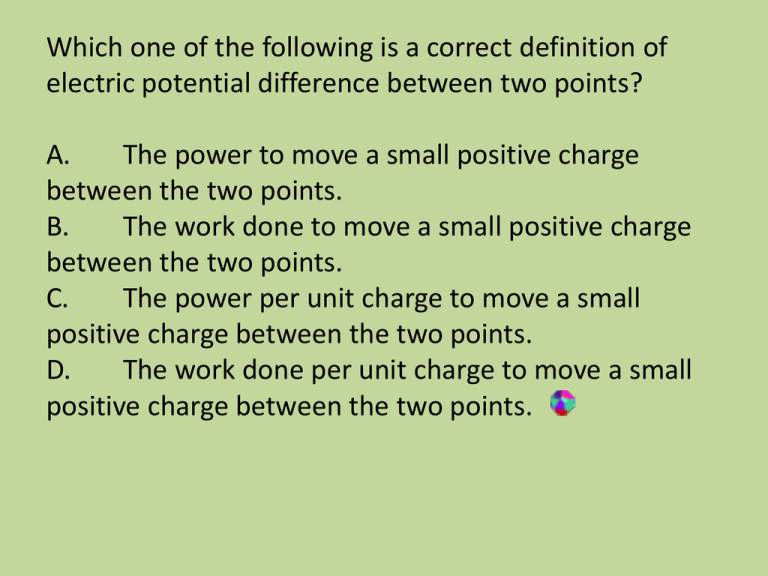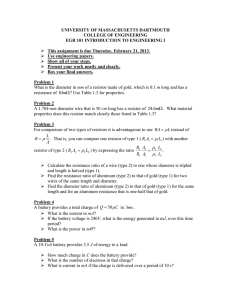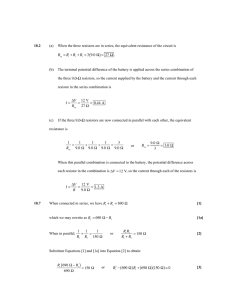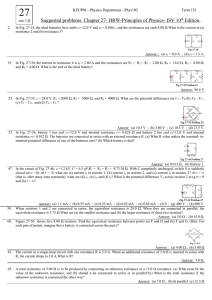Which one of the following is a correct definition of electric potential
advertisement

Which one of the following is a correct definition of electric potential difference between two points? A. The power to move a small positive charge between the two points. B. The work done to move a small positive charge between the two points. C. The power per unit charge to move a small positive charge between the two points. D. The work done per unit charge to move a small positive charge between the two points. The unit, the electron-volt is equivalent to A. B. C. D. 1.6 × 1019 J. 1.0 J. 1.6 × 10–19 J. 9.1 × 10–31 J. An electron and a proton are accelerated from rest through potential differences of the same magnitude. After acceleration the speed of the electron is ve and the speed of the proton is vp. Which of the following is the best estimate for the ratio vp/ve? A. 2000 C. (2000)-0.5 B. (2000)0.5 D. 1/2000 A proton and an alpha particle are accelerated from rest from the positively charged plate X to the negatively charged plate Y. + + + + proton + + X alpha particle mid-point – – – – – – Y At the mid-point between the plates, the proton has a kinetic energy EK. At this point, the alpha particle has a kinetic energy A. EK/2 . B. EK. C. 2EK. D. 4EK Which one of the following units is a unit of energy? A. B. C. D. eV W s–1 W m–1 N m s–1 A proton of mass m and charge e is accelerated from rest through a potential difference V. The final speed of the proton is A. B. C. D. (2Ve/m)0.5 2ve/m (Ve/m)0.5 D. Ve/m The graph shows the I–V characteristics of two resistors. When resistors X and Y are connected in series, the current in the resistors is 2.0 A. What is the resistance of the series combination of X and Y? A. 7.0 Ω B. 1.3 Ω C. 1.1 Ω D. 0.14 Ω Which one of the following lists a fundamental unit and a derived unit? A. Ampere, second B. Coulomb, kilogram C. Coulomb, newton D. Metre, kilogram Two resistors, of resistance R1 and R2, are connected in series with a cell of emf ε and negligible internal resistance. Which expression gives the potential difference across the resistor of resistance R1? A. B. R1 R1 R 2 C. R1 R2 R1 R 2 R1 D. R2 R2 R1 R 2 Which one of the following measurements is stated correctly to two significant digits? A. B. C. D. 0.006 m 0.06 m 600 m 620 m A conductor of constant resistance dissipates 6.0 W of power when the potential difference across it is 12 V. The power that will be dissipated in this conductor when the potential difference across it is 24 V is A. 6.0 W. C. 24 W. B. 12 W. D. 48 W. The resistive force F acting on a sphere of radius r moving at speed v through a liquid is given by F = cvr where c is a constant. Which of the following is a correct unit for c? A. C. N N m2 s–1 B. D. N s–1 N m–2 s The current in the circuit shown below is constant when the switch is closed. The energy transfer in the internal resistance r of the battery is 15 J when a charge of 40 C passes through it. For the same amount of charge, 45 J of energy is transferred in the resistor R. r R Which of the following gives the emf of the battery? A. 15 C. 45 V V 40 40 B. 30 V 40 D. 60 V 40 Gillian carried out an experiment to investigate the craters formed when steel balls are dropped into sand. To try and find the relationship between the diameter of the crater and the energy of impact of steel balls of the same diameter, she dropped a steel ball from different heights h into sand and measured the resulting diameter d of the crater. The data are shown plotted below. The original hypothesis, made by Gillian, was that the diameter of the crater is directly proportional to the energy of impact of the steel balls. Explain why the data does not support this hypothesis. The graph below shows the variation with current I of the potential difference V across a filament lamp. V / volts 1.2 1.0 0.8 0.6 0.4 0.2 0.0 0.0 0.5 1.0 1.5 2.0 I / mA The resistance of the lamp when I = 1.5 mA is A. 950 W. B. 400 W. C. 0.95 W. D.0.40 W. Three identical electrical heaters each provide power P when connected separately to a supply S which has zero internal resistance. On the diagram below, complete the circuit by drawing two switches so that the power provided by the heaters may be either P or 2P or 3P. The graph below shows the I-V (current-voltage) characteristic of an electrical component T. On the graph, draw the I-V characteristic in the range V = 0 to V = 6.0V for a resistor R having a constant resistance of 40Ω. 150 100 I / mA 50 0 0.0 2.0 4.0 V/V 6.0 8.0 Which of the following is the best estimate, to one significant digit, of the quantity: π 8.1 ? 15.9 A. B. C. D. 1.5 2.0 5.8 6.0 A battery of internal resistance 2 Ω is connected to an external resistance of 10 Ω. The current is 0.5 A. What is the emf of the battery? A. 1.0 V B. 5.0 V C. 6.0 V D. 24.0 V The electromotive force (emf) of a cell is defined as A. the power supplied by the cell per unit current from the cell. B. the force that the cell provides to drive electrons round a circuit. C. the energy supplied by the cell per unit current from the cell. D. the potential difference across the terminals of the cell. A resistor of resistance 12 Ω is connected in series with a cell of negligible internal resistance. The power dissipated in the resistor is P. The resistor is replaced with a resistor of resistance 3.0 Ω. What is the power dissipated in this resistor? A. B. C. D. 0.25 P P 2.0 P 4.0 P Two rectangular blocks, X and Y, of the same material have different dimensions but the same overall resistance. Which of the following equations is correct?







